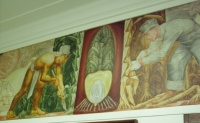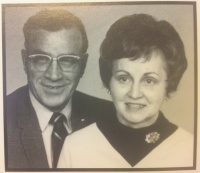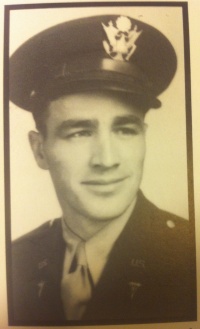Difference between revisions of "Franklin John Linn"
m (Reverted edits by 222.76.152.158 (talk) to last revision by Jim.lindstrom) |
|
| (3 intermediate revisions by 3 users not shown) | |
(No difference)
| |
Latest revision as of 02:47, 11 April 2012
| Franklin John Linn | |
|---|---|
| Born |
November 9, 1911[1] Shelby, Iowa, USA |
| Died |
June 10, 2005 (aged 93)[2] Sheffield, Iowa |
| Spouse | Ann Thorson (m. 1939–2002), Radcliffe, Iowa |
| Children |
Annette Linn James Frank Linn Rebecca Jeanette Linn |
| Parents |
Franklin Bryce Linn Hannah Elizabeth Walker |
| Relatives |
Harry Deforest Linn (Brother) Dwight Russel Linn (Brother) Lily Gladys Linn (Sister) Laura Lavina Linn (Sister) Hugh Alva Linn (Brother) Jacob Bryce Linn (Brother) Mary Fern Linn (Sister) Leslie Leonard Linn (Brother) Samuel Dale Linn (Brother) Everette Edward Linn (Brother) |
Entry in The Clan Linn in the Twentieth Century[edit]
Franklin John Linn (h7768) was born on 9 November 1911. After graduation from Shelby High School, Frank enrolled in the School of Veterinary Medicine at Iowa State College in Ames. He was a member of the varsity wrestling team there. In his senior year Frank was captain of the Iowa State wrestling team, conference champion, and Midwestern A.A.U champion. He achieved All-American status in 1937 and 1938 in the National Collegiate Championships.
In 1936, Frank was hired to pose for a mural which was being prepared fro the Ames Post Office. Frank posed in the artist, Lowell Houser's home in downtown Ames during the winter and spring of 1936 and 1937. The theme of the mural was: "The Development of Corn". Frank received fifty cents an hour for his work. The mural still graces the lobby of the Ames Post Office.

|
Frank married Ann Thorson on 31 December 1939, and they moved to Sheffield where Frank practiced veterinary medicine.
Frank had signed up as a U.S. Army Reserve officer when he graduated from Iowa State College, with absolutely no anticipation of ever being called to activity duty. The following was his view of World War II:
We were called up in September of 1942. By December I was on my way to India with two hundred fourteen army officers of all ranks. Unknown to us at the time, our objective was to train and direct the Nationalist Chinese Army against the Japanese. December 8, 1942 found us pulling into Pearl Harbor, exactly one year and one day--to the hour--after the attack by the Japanese.
We arrived in India at ramgarh, a former Italian prisoner of war camp, run by the British. It was located about two hundred miles northeast of Calcutta. There was a medical hospital staffed by Dr. Seagrave and his Burmese nurses, who had fled Burma ahead of the advancing Japanese army. Chinese personnel were being flown in from China. Chaubua, an American airbase a short distance north, was the main jump-off point for those flights destined to 'fly the hump' (Himalaya Mountains). Since there were no roads across the mountains, they carried supplies and troops in and out in this manner, supplying the rest of the Nationalist Army in China.
We formed two mountain pack divisions, each consisting of ten thousand troops and two thousand horses, to pack supplies and 75mm cannons over the mountain trails and jungles of Burma. A veterinarian from Ohio and I were assigned to sick call for the for thousand horses and mules. About a thousand of these were large horses from the Pacific Islands and the rest were medium to small pony size, purchased in India through 'reverse lend lease'. The latter were of somewhat questionable quality. Each horse was assigned to an individual soldier, so we were constantly plagued with over-feeding, mishandling, and injury problems, multiplied by the fact that every shipment of grain and hay was different.
In September 1944, I was assigned as train-officer in charge of sending a trainload of horses and troops to Assam, a state in northeast India, to set up camp on the 'Ledo Road'. This road was to be built over the mountains to North Burma, and would ultimately connect with the 'Burma Road' already built from China to Burma. It ran but a short way over the border of Burma, probably fifty miles. It was on this stretch that Dr. Seagrave 'The Burma Surgeon' had maintained his hospital. Movement in this area was governed by the weather. During the monsoon season, which started in April and ended in early September, we received over three hundred inches of rain. The rest of the divisions were moved up and camped along the road, which was a 'metal road' during the winter dry season. ('Metal road' was a British term for gravel or rock covered road.) A constant cloud of dust surrounded it, as this was the main supply line of the American road-builders moving through the jungle and mountains ahead of us. The engineers were also building a supply line for gasoline alongside the road: a six inch pipeline bolted together on the surface of the ground; of course it had plenty of leaks!
Upon reaching Ledo an American major, Dr. Paul Boyer, was assigned to the 22nd Division with me. The two of us and twenty enlisted men continued treating horses along jungle paths and those brought into our camp.
for my tour down in the forward area I had chosen a small Chinese pony, about three feet tall at the shoulder, to pack several changes of shirts, trousers and a jungle hammock with enclosed mosquito netting and a rubberized roof for me. I also had a small bag of toilet articles, which included chopsticks, as all meals were eaten with the Chinese. Dr. Boyer chose a large gelding, 'Big Red', which he rode, while I walked with the soldiers. We usually camped near division headquarters, so we were in a fairly safe area, about three or four miles behind the fighting. The common strategy was to surround a Japanese unit for a few days, then go into the area and find them gone!
By this time I had become somewhat conversant in Chinese. One day during the early rainy season I heard two Chinese soldiers talking, and one told about being near the Japanese troops. The Chinese had cigarettes and no matches; the Japanese had matches without cigarettes, so they tossed the shorted items across to each other.
The natives occasionally used elephants to do the heavy work. I discovered that horses and elephants have a mutual fear of each other! One day we were camped beside a stream with a thirty foot beach. Some Chinese came by with a small elephant about six feet tall, leading it by a string tied around its tongue. When the elephant saw our horses it immediately panicked and charged into the river! The Chinese promptly dropped their rifles and took chase, bringing the elephant back to shore. The elephant again streaked into the river. This time they covered his head and eyes with a 4 X 8 rubberized ground sheet, the kind used under tents and beds. When they got the elephant out and ready to go, they picked up their rifles in preparation to depart. The elephant gently reached up with his trunk and slowly removed the ground sheet. One look at my pint-sized horse and he again charged into the water! The Chinese finally retrieved him and headed back the way they had come. That was the last I saw of the little elephant.
Occasionally General Joseph (Vinegar Joe) Stilwell, the American officer in charge, came to our headquarters, but he didn't stay long.
At Kamaing we were overtaken by another monsoon, and we spent the next three months living in a section of bombed-out store. I spent my time with an American, Captain Kenneth Laney from South Carolina, who was in charge of supply requisition. He managed to get the equipment necessary to hunt and fish. We had had no fresh meat for two years except for what we had furnished ourselves and were determined to improve our culinary fare! First we took a native dugout canoe out in the river and dropped a hand grenade into the water. The resulting explosion knocked all the caulking out of the cracks in our boat, since we were too slow in getting away; we barely made it back to shore! From a retreating British unit we then obtained a small canvas boat, and after requisitioning a small outboard motor we could go up and down the river shooting peacocks and dynamiting fish to our hearts' content. Later we got two very large fish -- over one hundred fifty pounds -- and a picture appeared in the New Delhi paper detailing our tremendous catch. Sometime later one of the commanding officers who had seen the newspaper article asked what we had used for bait. Reluctant to go into a great deal of detail, we merely described it as a special 'expanding bait'.
One day Laney and I went on one of our exploratory excursions up a small side stream that was just wide enough to float our canvas boat and motor. We rounded a bend in the stream and there on the bank surrounded by trees was a new medium-sized Caterpillar tractor! It was in brand new condition! There were no roads wider than a footpath for miles around. It was located approximately where the new road would be coming through in about six months. How did it get there? Parachute?
Lane and my hunting excursions were a carry-over from Ramgarh, where we often made all-night hunts with a jeep. We had a spot-lighter in the back and a gunner in the front with some tracer ammo mixed in so we could see where it was going. When the spotter saw some eyes, he kicked the driver, who stopped, and the gunner took over. It worked pretty well! Colonel Estabrook, who often accompanied us, was the son-in-law of General Stilwell. I understand he bagged a tiger that way after I left for Burma.
The following fall we again moved southeast over the mountains into a valley where a large number of gliders had been towed in. They were dropped into a big treeless valley full of tall grass. An American sergeant drove out to meet us. There was no road for miles, but he was there to guard the wreckage of gliders, planes and barrels of high-test fuel... For all I know he is still there!
We soon arrived in Myitkina, where the Japanese were surrounded on two sides with their backs to the river. After several changes of command and three months of fighting, the Chinese rushed in to find--as usual--nothing.
Our division had orders to fly to China. As we were getting ready to go, my orders came through sending me back to the U.S.A. My final months were spent at Fort Snelling, near St. Paul, Minnesota inspecting eggs, turkeys, and cheese for the army.
Frank was president of the Iowa Veterinary Medicine Society and a member of the Iowa State Veterinary Medical Examining Board. He was a member of the Methodist Church, Masonic Lodge, the Shrine and the Order of the Eastern Star. He served for eleven years on the executive board of North Iowa Area Community College. Frank and Ann had three children: Annette Linn, James Frank Linn, and Rebecca Jeanette Linn.
AVMA Obituary[edit]
Dr. Linn (ISU '38), 93, Sheffield, Iowa, died June 10, 2005. He practiced in Sheffield for more than 40 years. Dr. Linn was a past president and lifetime member of the Iowa VMA and served on the Iowa Board of Veterinary Medicine. He also served as mayor of Sheffield, on the city council, as a member of the fire department for 45 years, and on the board of directors of the North Iowa Area Community College. Dr. Linn was an Army veteran of World War II, attaining the rank of captain.
Dr. Linn's three brothers, also deceased, were veterinarians practicing in Iowa as well. Hugh (ISU '30) practiced in Gilmore City, Samuel (ISU '41) in Humboldt, and Everett (ISU '50) in Waukon. Dr. Linn's nephew, Richard (MO '83) practices in Ozark, Mo., and nephew David (ISU '79) and his wife, Sharon Hurely (ISU '79), practice in New Ulm, Minn.
Dr. Linn's wife, Ann; two daughters; and a son survive him.[3]
Globe Gazette Obituary[edit]
SHEFFIELD — Dr. Frank Linn, 93, longtime Sheffield veterinarian, died Friday (June 10, 2005) at the Sheffield Care Center.
A Celebration of Life will be held at 11 a.m. Monday at First United Methodist Church Sheffield with the Rev. R. Karl Watkins presiding. Military honors will be provided by Harlow Ray Massee Post No. 277 American Legion. Interment will be at a later date at Hillside Cemetery, Sheffield.
His family will greet friends from 5 to 8 p.m today at Retz-Grarup Funeral Home, Sheffield.
Franklin John Linn was born November 9, 1911, near Shelby, Iowa, a son of Franklin Bryce and Hannah Elizabeth (Walker) Linn. He attended country school and graduated from Shelby High School. Frank then entered the School of Veterinary Medicine at Iowa State College. While there he was a member of the varsity wrestling team and was named an All-American in 1937 and 1938. He also posed for the mural "The Development of Corn" which is still prominently displayed in the Ames Post Office.
On December 31, 1939, Frank was united in marriage with Ann Thorson at the Methodist Episcopal Church in Radcliffe, Iowa. They made their home in Sheffield, where Dr. Linn set up his veterinary practice.
In 1942 Dr. Linn was called up for the U.S. Army and as a captain served in the China, Burma, India Theater. His unit was charged with training the Chinese to fight against the Japanese. After the war, Frank returned to Sheffield, resumed his practice and worked to support Sheffield and the area.
Frank was a member of First United Methodist Church in Sheffield. He served his community as city council member, mayor and was recognized for 45 years on the Sheffield Fire Department.
He was Commander of American Legion Post No. 277 and active in the Masonic Lodge, the Shrine and Order of the Eastern Star. Frank also spent 11 years on the Executive Board of North Iowa Area Community College. Active in professional organizations he served as president of the Iowa Veterinary Medicine Society where he was a lifetime member and served as a member of the Iowa State Veterinary Medical Examining Board.
Frank will be remembered for his great sense of humor and as one who loved a good joke. He was famous for his Halloween antics and helped transform the holiday in the community. He kept active as a woodworker, potter and rock collector.
He was a very determined man. After he was diagnosed with multiple sclerosis, he set out to learn to ride a unicycle, just to show that he still could. As a true outdoorsman, he enjoyed all outdoor activities and there was nothing he couldn't do or didn't try. Even in his 80s he went to the Boundary Waters camping.
Of all the activities Dr. Linn was involved with, he enjoyed most the time spent with his family, especially his grandchildren and great-grandchildren.
Dr. Linn is survived by his wife of 65 years: Ann; three children: Annette Linn, Englewood, Colo., Jim (Mary) Linn, Coralville, Rebecca "Becky" (Galen) Stahle, Deep Haven, Minn; four grandchildren: Katherine (Jeffrey) Brandel, Rebecca (Mark) Passavant, Galen James "Jamie" Stahle and fianceé, Katie Frederick, Langdon McKendrie Stahle; two great grandchildren: Elizabeth Zoe and Sean Leonard Brandel; sisters-in-law: Helen Linn, Grace Linn and Jane Linn; and numerous nieces and nephews.
Dr. Linn is preceded in death by his parents; sisters: Gladys Simon, Laura Linn and Fern Robinson; brothers: Harry, Dwight, Hugh, Jacob, Leslie, Samuel and Everett. --- Retz-Grarup Funeral Home, (641) 892-4241[4]
Photos[edit]

|

|
See Also[edit]
Notes[edit]
- ↑ The Clan Linn in the Twentieth Century, p567-70
- ↑ American Veterinary Medical Association, 2005.
- ↑ American Veterinary Medical Association, 2005.
- ↑ The Globe Gazette (Mason City, Iowa), June 12, 2005.